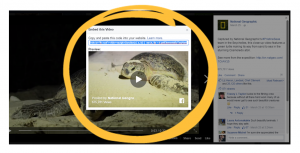Study: Every second Facebook user shares a video
A few years ago, the social network headed for the popularization of video content, thereby entering into competition with YouTube. In 2015, the difference was enormous: cumulatively, Americans spent 8,061 years on YouTube, while watching videos on Facebook took “only” 713 years. According to a study by Quintly, the situation has changed dramatically over the past two years.
As part of the study, Quintly staff studied over 6 million posts from 162,000 users. The data obtained showed that video on Facebook is becoming more and more native and viral content for users of the social network. There are several reasons for this. For example, Facebook videos run automatically, and they are also organically integrated into the feed, the user does not need to make any extra movements.

As a result, videos were shared on 53% of the studied profiles: people do not just watch videos in their feed, they willingly share them with friends, which only adds to the virality of the videos. And having a convenient tool for this (the “Share” button), the so-called Share Rate on Facebook is 1055% higher than on YouTube. Moreover, about 90% of users record videos themselves, which is easily done after starting live broadcasts. Popular pages with more than 10 million followers are no exception, with a 35% increase in the number of videos created for Facebook over the past year.
Obviously, YouTube’s popularity is not falling: not so long ago, representatives of the service said that every day people watch 1 billion hours of content there. But Mark Zuckerberg is actively working to make Facebook the new television. For example, an application for Smart TV was released, and within the company there is a large multi-million dollar fund to finance the shooting of commercials for stars and influencers.
YouTube trends experts conducted a study to find out how the pandemic has affected video content and audience needs. The main conclusion they came to is that videos play a significant role in people’s lives primarily because they give them a sense of community.
The popularity of live broadcasts
During quarantine, people have decreased the number of social interactions. And joint video viewing (offline or online) replaced them with full-fledged communication. This has contributed to the growing popularity of live broadcasts. Over the past year, 85% of users have watched them at least once.
79% of YouTube viewers believe that watching videos together, such as on TV, strengthens relationships.
Weddings were broadcast live (Korean channel Wootso), musicians collected online concerts (Lofi Girl channel), and the NASA channel streamed the landing of the Perseverance rover, which was watched by 2 million people at the same time.

During the pandemic, live broadcasts in the “Doing Together” style have also gained popularity, the researchers note. In them, the authors of the videos do something that the audience can immediately repeat. For example, they decorate the house, clean, study.
Down with the fourth wall
Due to the fact that almost the entire world switched to remote work last year, the boundaries between the personal and the public have blurred. People have a need to show their life as it is, without embellishment. And the audience began to expect the same openness and honesty from the authors of the video.
YouTube analysts believe that videos in which the author breaks the fourth wall and gives viewers a sense of community will have popularity. For example, Indian stand-up comedian Samai Raina began regularly streaming an online chess game during the pandemic, during which he interacted with other comedians and viewers. His videos for 9 months gained more than 330 million views.
Immersive video
The authors of the study say that multi-sensory videos that can immerse viewers in the plot and action are now more popular than ever – ASMR videos, video podcasts, first-person films.
In addition, during the pandemic, participation in flash mobs has become popular entertainment. For example, musicians and video makers from all over the world performed the seventeenth-century sailor song Wellerman. It was once sung by New Zealand whalers to boost morale and cope with hard work.
